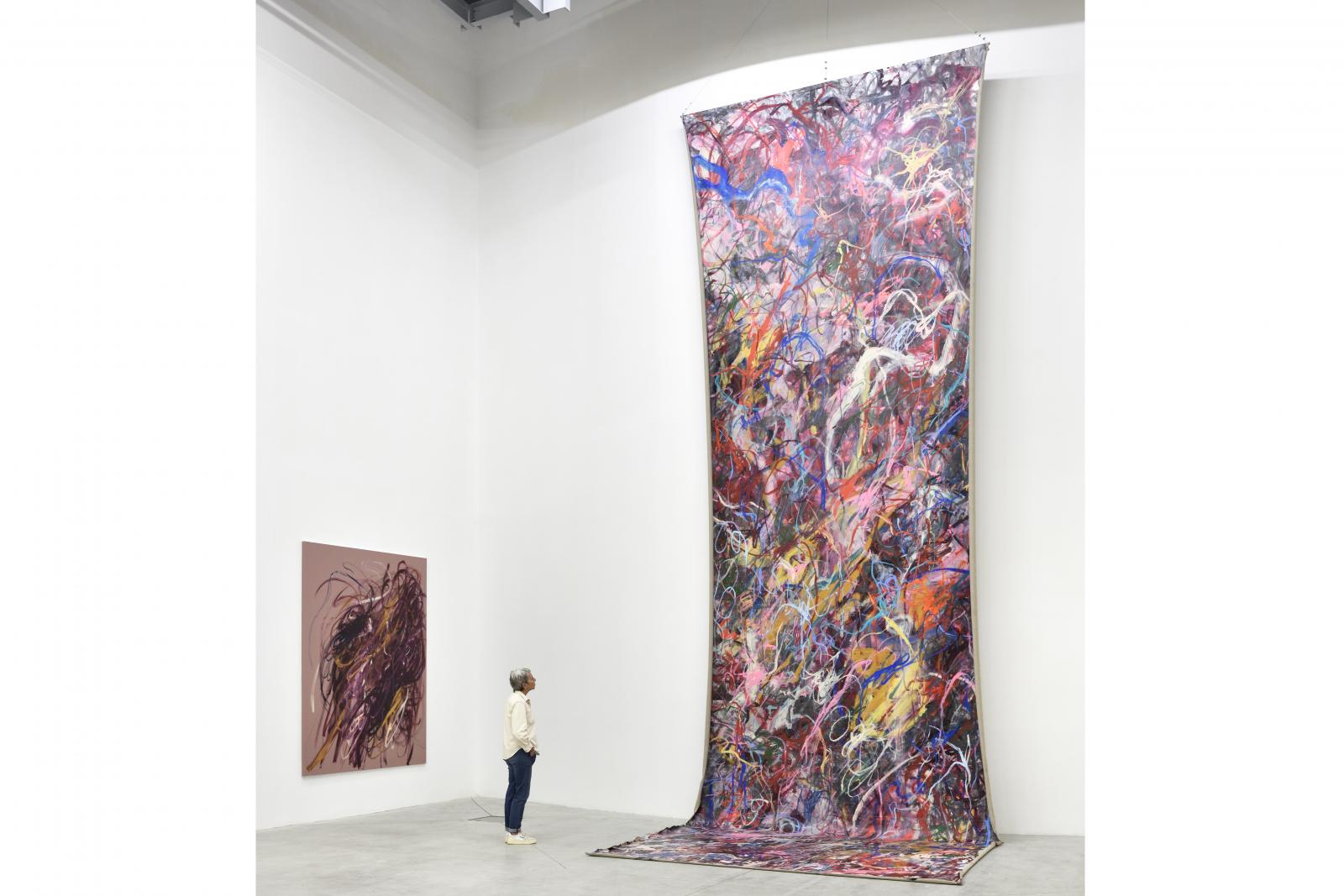a'driane nieves
Let's dance our way back home
Born in 1982 in San Antonio, Texas, USA. Lives and works in the Great Philadelphia Area.
With generous support from galerie Marguo, Paris.
Painting needs everyday heroes, extraordinary knights of the pictorial apocalypse
The exhibition features a series of new paintings created for the (large) white cube that has become known in the history of the Consortium as the white box. The roughly ten-meter cube has a wall with a double, convex and concave, curve that optically produces an effect of quasi-vertigo—an architectural feature that does not have instant appeal for the artists who are invited to show there. Right away a’driane nieves was eager to riff on it in the visual score of fresh paintings she planned for the cube.
This is the first time that every dimension of this cube—which stands apart from the pathway leading through the ground level galleries—has been enlisted, with particular emphasis on its verticality.
The artist capitalized on the sharp horizontal/vertical and planar/curvilinear contrasts to position her paintings but also to arrange them in a perfectly orchestrated formal and chromatic scheme.
Born in 1982 in San Antonio, Texas, a’driane nieves lives with her family in the Philadelphia suburbs. After serving in the American Air Force and suffering from subsequent neurological side effects, a’driane, a painter and writer, founded the Tessera Arts Collective in the Kensington area in the northern outskirts of Philadelphia. An organization that supports Black, Indigenous, Latinx, Asian, and Pacific Islander women (as well as queer, trans, femme) artists and non-binary abstract artists in finding the place they deserve in the art world.
Her roughly fifteen-year practice as a self-taught painter has gained her a special place in the current abstract art scene. Influenced by Abstract Expressionists such as Joan Mitchell, Bernice Bing, and associated Black artists like Alma Thomas and Mary Lovelace O’Neal, a’driane nieves strongly believes in the power of abstraction, both its formal language and its compositions, to surmount her childhood trauma and create a serene space to express her long repressed emotions.
Can painting go beyond what a fine-tuned performance can accomplish therapeutically speaking? Indebted to art and her story, a’driane has decided to embrace it with courage and insight.
The performative dimension touches the pictorial surface, and tracing the elaborate layering of colorful marks to uncover her creative process would be laborious, tricky, and in vain.
Would we be able to discern a plan or a strategy for selecting the colors, hue after hue?
Is improvisation, like the glorious moment of free jazz, based on mastery and openness, on constancy and dissonant deviation?
The monochrome grounds, chosen from pastel colors or left gesso white from the preparation of the linen canvas, are placed to accommodate the colorful scrawled lines applied with brushes or the artist’s fingers—and eye.
For anybody who wants to tackle its whole volume, this white cube is worthy of a more striking approach than a mere hanging along a median line at the eye level of the ideal visitor.
Unrolled and hung at a height of over seven meters, an unstretched canvas entangled with webs of colorful twists hits the floor, either ending there or beginning some 150 centimeters from the wall.
a’driane wanted to share images with us that show the stream of scrawled linen right on the paved driveway leading from the garage of her home in a middle-class suburb of Philadelphia to the main street of the housing development. Temporary street art in the guise of an outdoor studio, where a’driane had to struggle between modesty and pride in daring to make the work in plain view of her neighbors.
A sidewalk Pollock, a suburban Mathieu, nieves’s painting for the curved wall possesses the bold assertiveness of a visual poem—think the Last Poets, calligraphers of speech—inscribed on the entryway to a family tract house.
To quote a’driane referring to the title of the exhibition: “The text I came up with for the neon painting, ‘let’s dance our way back home,’ is inspired by writer Alice Walker’s book of poems, Hard Times Require Furious Dancing. It wasn’t my original intent for it to be the title of the exhibition. Walker’s book, however, is one of the few books that have informed the paintings in the show, especially the one I just completed. I was hoping to have a reference to its title as a way to acknowledge this.”
Apart from exhibitions, a’driane pursues writing in preparation for tackling the canvas, confiding secrets on the A3 sheets of a sketch book. The handwriting is already calligraphy—without veering into a mystical Orientalizing jumble—sentences in cursive and the oily line of pastel are composed like paintings. Figurative, they tend somewhat toward drawing, toward painting. A discussion together gave rise to the idea of having some double pages removed and pinned to the wall alongside the torrent of vertical painting, and extending to the exhibition book itself in the round central space of the Consortium Museum’s bookshop. Accessible to all, it finds itself in good company among an array of books published and/or distributed by Les presses du réel, and chosen by the artist for this occasion.
beloved, let’s dance our way back home (these times of rage, joy, grief, and renewal require furious dancing)
— Seungduk Kim and Franck Gautherot





